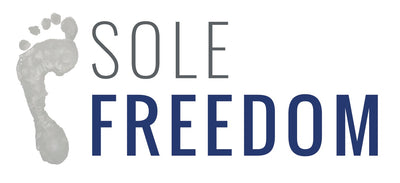If you’ve been following our journey at Sole Freedom, you already understand the why behind switching from conventional shoes to natural footwear. Now it’s time to explore the how.
Transitioning to minimalist shoes or barefoot-style footwear isn’t something that happens overnight. It’s a gradual process that allows your body—especially your feet—to rebuild strength, restore mobility, and return to natural movement patterns. Done right, this shift becomes one of the most powerful health upgrades you can make.
Let’s walk through a few essential principles to help you transition successfully, safely, and sustainably.
1. Listen to Your Body’s Signals
Your body is always giving you feedback—especially your feet. If something feels off, sore, or tight, take note. On the flip side, if something feels better than usual, that’s feedback too.
Tuning into these signals is the most reliable way to guide your transition. Sore feet after a long walk? Scale it back a little and spend time on recovery with gentle movement and soft tissue release. Feeling great? That’s your green light to keep going.
It’s all about staying in the Goldilocks zone—not too much, not too little. That’s where real adaptation happens.
2. Start with Your Daily Drivers
The shoes you wear the most have the greatest influence on your foot health. That’s why we recommend starting your journey with a pair of natural “daily drivers”—everyday minimalist shoes designed for walking, working, and living.
Wear them consistently for a few weeks before you jump into running, jumping, or high-intensity activities. Every step you take in foot-shaped, flexible, zero-drop footwear is a step toward stronger, more functional feet.
Trust the process. Let your body adapt at its own pace.
3. Begin a Simple Daily Practice
A short daily movement routine can dramatically speed up your transition. Five minutes a day is all it takes.
Focus on foot mobility, toe strength, ankle stability, and balance. You don’t need fancy equipment—your body weight is enough. Over time, this consistent practice helps your feet handle more load and movement in less supportive shoes.
Not sure where to start? Try a daily SoleMate session. It’s quick, effective, and accessible for everyone.
4. Accept That Overdoing It Might Happen
Sometimes you’ll push a little too far—and that’s okay. Overdoing it is part of the learning curve. It gives you valuable insight into your limits and helps you adjust your pace.
Just remember: the more rigid and supportive your current shoes are, the longer your feet may take to adapt. Progress might be slower, but it’s still progress. Be patient.
5. Phase Out Unnatural Footwear Gradually
You don’t need to throw out your entire shoe rack overnight. Slowly reduce your time in narrow, stiff, cushioned footwear. Replace them one by one with foot-healthy alternatives.
Think of it like upgrading your system. Each new natural shoe helps restore your body’s baseline function.
6. Connect With a Supportive Community
Foot health is a personal journey—but it doesn’t have to be a lonely one. Join others on the same path through the TFC digital community. You'll find resources, guidance, and real humans ready to share their experience and support.
Health is a team sport. Surrounding yourself with like-minded people makes the process more fun—and a lot more sustainable.
One Step at a Time
Switching to natural footwear is one of the most impactful health decisions you can make. By listening to your body, starting with your daily drivers, and committing to just five minutes of movement each day, you’re laying the foundation for long-term foot health.
The key? Consistency. Patience. And a little curiosity along the way.
We believe in your journey—and we’re here to support you every step of the way. Explore our curated collection of natural footwear to find your perfect daily drivers and take that first empowering step.
Thanks for reading. And if you know someone who could benefit from this blog, please share it with them!
Until then—stay grounded, stay curious, and take care of your soles.
— Nick
FAQ: Transitioning to Natural Footwear
1. How long does it take to transition to natural footwear?
The transition timeline varies depending on your starting point. If you've been wearing highly cushioned or narrow shoes for years, it may take several months to fully adapt. Most people start seeing significant improvements in foot strength and comfort within 4 to 12 weeks when wearing natural footwear consistently and incorporating daily foot exercises.
2. Can I run or work out in natural shoes right away?
It’s best to start slow. Begin with wearing natural shoes for walking and everyday use—your “daily drivers.” Give your body a few weeks to adjust before jumping into high-impact activities like running or court sports. This gradual approach helps prevent injury and allows your feet to build strength naturally.
3. What are the signs I’m transitioning too quickly?
Common signs of doing too much too soon include foot soreness, tight calves, heel pain, or arch fatigue. These are your body’s signals to slow down. Reduce intensity, increase recovery time, and focus on mobility and strengthening exercises before progressing again.
4. Do I need special equipment to start the transition?
No special equipment is required. A simple 5-minute daily routine focusing on foot mobility and balance is enough. Tools like the SoleMate foot training system can enhance your practice, but they’re optional. The key is consistency, not complexity.
5. What makes natural footwear better for foot health?
Natural footwear mimics the barefoot experience while still offering protection. It typically features a wide toe box, flexible sole, and zero-drop design—all of which encourage natural movement, improve posture, and allow your feet to move and function the way they were designed to.

